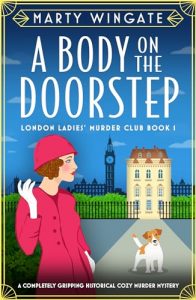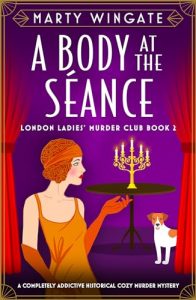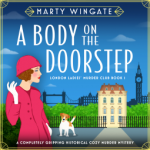 Murder of a Suffragette (London Ladies' Murder Club #4) by Marty Wingate
Murder of a Suffragette (London Ladies' Murder Club #4) by Marty Wingate Format: eARC
Source: supplied by publisher via NetGalley
Formats available: paperback, ebook, audiobook
Genres: cozy mystery, historical mystery
Series: London Ladies' Murder Club #4
Pages: 331
Published by Bookouture on October 28, 2024
Purchasing Info: Author's Website, Publisher's Website, Amazon, Barnes & Noble
Goodreads
Women from all around the country have joined together to fight for the vote. But when one of them is killed, only amateur sleuth Mabel Canning can halt a murderer’s campaign…Fellbridge Hall, England: Mabel Canning is thrilled to be organising a suffragette conference. But when all the women are settled in the sprawling country mansion, she barely has time for a sip of gin before chaos ensues. Leading suffragette Annie Harkin has been found murdered in her bed, clutching a white feather in her outstretched hand…As the guests clamour for justice for Annie, young police officers Ned and Ted arrive in time to trip over the banners and be roundly ignored. And with a killer on the loose, the suffragettes swiftly vote for Mabel and her pals to take control. When it comes to solving mysteries, there’s nobody equal to the London Ladies’ Murder Club!But soon it’s clear many a suffragette is hiding a secret under her sash. Eccentric veteran of the cause Dorothea Goose is acting rather flighty; why is she so afraid of the police? Would Annie’s rival go this far to replace her as leader? Or has someone taken a life to stop the cause of women’s lib?Then Mabel uncovers what happened to Annie’s closest comrade in the years before the war, and she is sure the answers lie in the past. But will Mabel be elected as the killer’s next victim? Or can she crack the case and save the fight for Votes for Women?A totally addictive whodunnit bursting with suspense and sparkling with wit, from USA Today bestseller Marty Wingate. Perfect for fans of Agatha Christie, Richard Osman, Verity Bright and T.E. Kinsey.
My Review:
 As much as it makes Mabel Canning’s father worry about her when she’s on her own in London, it’s clear from this fourth entry in the utterly charming London Ladies’ Murder Club that her home, the tiny village of Peasmarsh and its surrounds, are better off if Mabel is in London.
As much as it makes Mabel Canning’s father worry about her when she’s on her own in London, it’s clear from this fourth entry in the utterly charming London Ladies’ Murder Club that her home, the tiny village of Peasmarsh and its surrounds, are better off if Mabel is in London.
Not because of Mabel herself, but rather because she seems to have a fortunately unfortunate knack for finding herself in the midst of murder investigations. Peasmarsh’s population is much too small to survive the number of deaths that Mabel and her ‘club’ become involved with on the regular!
As this case is a, well, case in point. Mabel has returned to the Peasmarsh area to serve as the personal secretary to Lady Emma Fellbridge at nearby Fellbridge Hall. Lady Emma has known Mabel all of Mabel’s life, and Mabel was a frequent guest at the hall as her dearest childhood friend was Lady Emma’s daughter-in-law until the Spanish Flu took her much too soon.
Lady Emma was one of the heroines of the suffragette movement, and has convened a meeting of her fellow campaigners at Fellbridge Hall to consider the next phase of their work. At the time this story takes place, 1922, women 30 years of age and over who were property owners or householders, or married to men who were either of the above, or occupiers of rental property over a certain rate, or university graduates had the right to vote, while men could vote from age 21 with considerably fewer restrictions. These women, who once chained themselves to gates and went on hunger strikes in prison, are determined to continue the fight for equality into a new generation.
Mabel and her ‘Murder Club’ have arrived at Fellbridge Hall under the auspices of Miss Kerr’s Useful Women’s Agency for which Mabel works and of which her ‘Murder Club’ is an active part. She’s not expecting for the club to be active at the suffragette meeting – but that’s exactly what happens when one of the suffragettes, in fact, one of the women in contention to become the next leader of the movement, is murdered.
Mabel has more experience with murder investigations than the local police do – and Detective Inspector Tollerton of the Met is just far enough away in London and snowed under with urgent cases in the metropolis to leave Mabel temporarily in charge. Somewhat to his own surprise – and even occasional chagrin – Tolly is forced to leave Mabel leading the investigation, seconded by WPC Hildy Wardle, several members of her Murder Club, and two local constables who desperately need someone to give them orders.
When a second suffragette is murdered, and Mabel herself is attacked twice, she’s certain that she’s on the trail of a murderer – but the clues are misleading at best and confoundingly conflicting at worst. She’ll need the wits, and the skills, of every single member of the London Ladies’ Murder Club to catch the killer – before he strikes again.
 Escape Rating A-: I’ve been looking forward to reading this latest entry in the London Ladies’ Murder Club since the minute I finished the previous book, A Body at the Dance Hall. And it absolutely was worth the wait! My one regret about having finished this book is that I don’t know for certain that there will be a next book in the series – or when that MUCH hoped for book will be published. (I have my fingers crossed!)
Escape Rating A-: I’ve been looking forward to reading this latest entry in the London Ladies’ Murder Club since the minute I finished the previous book, A Body at the Dance Hall. And it absolutely was worth the wait! My one regret about having finished this book is that I don’t know for certain that there will be a next book in the series – or when that MUCH hoped for book will be published. (I have my fingers crossed!)
I’ve fallen for this series because I’ve taken to Mabel Canning as the protagonist. The charm of the series rides very much on her shoulders – and it’s just terrific to follow the investigation from inside her thoughtful, intelligent head.
What makes this series work for me is that Mabel does an excellent job of straddling the line between being a woman of her own time and not ours, while still having a realistic amount of agency to go about her business – which in Mabel’s case is investigating murders.
She does have to reckon with the attitudes towards women’s roles and women’s place, but because of her particular era, just post-World War I, she’s part of a time when things were still in flux because of the war – and because the war killed a generation of young men leaving many women without the prospects of marriage even if they wanted it.
The series does not shy away from the fact that some didn’t, including Mabel’s friends Skeff and Cora, as well as, it turns out, both Lady Emma and the first victim, Annie, even though the earlier generation did follow tradition – at least to all outward appearances. And it’s the degree to which lip service was given to those outward appearances that creates one of the sets of misunderstood clues and red herrings that makes this particular case so juicy.
Another part of the series that works particularly well is the way that it dives into women’s experiences and women’s history. In this particular case, the suffragette movement, its sister movement, the suffragists, and the contention between the two. Suffragettes were the considerably more militant arm of the movement – while suffragists preferred to conduct their campaign via entirely legal means. There existed tension between the two as well as an acknowledgement that some women switched from one to the other (and back and again) over time.
Voting rights for women on the same terms as men was finally granted in 1928, but at the time of this story the fight was not yet won. The question before the gathered women centered on just who would be the best person to lead that fight. The strong personalities of many of the women involved made leadership of the movement a possible motive that Mabel was forced to consider – no matter how much she wished it was not.
Part of what makes Mabel such a fascinating protagonist is the way that she navigates her world, and the push and pull of loving her father and wanting to remain in his good graces – he’s a good man and has been an excellent father – but still NEEDS to live her own life on her own terms gave this entry in the series a very personal touch as well.
 Her father wants her to be safe – but he recognizes that safe on his terms is not what his daughter was built for. It was wonderful to see a supportive father-daughter relationship in a female-led historical mystery – as opposed to the more usual situation, where dear-old-dad has often been the impetus for his daughter’s flight from conventionality in one way or another. If not several.
Her father wants her to be safe – but he recognizes that safe on his terms is not what his daughter was built for. It was wonderful to see a supportive father-daughter relationship in a female-led historical mystery – as opposed to the more usual situation, where dear-old-dad has often been the impetus for his daughter’s flight from conventionality in one way or another. If not several.
In other words, there are a LOT of reasons why I enjoy the London Ladies’ Murder Club series and this entry is certainly an excellent example of why. I did figure out WHOdunnit a bit early, although the WHYdunnit took a bit longer. I’m here for Mabel Canning, and I hope you will be too. If you haven’t discovered her yet, start with A Body on the Doorstep to see just how the London Ladies’ Murder Club got its start!






















One thought on “A- #BookReview: Murder of a Suffragette by Marty Wingate”